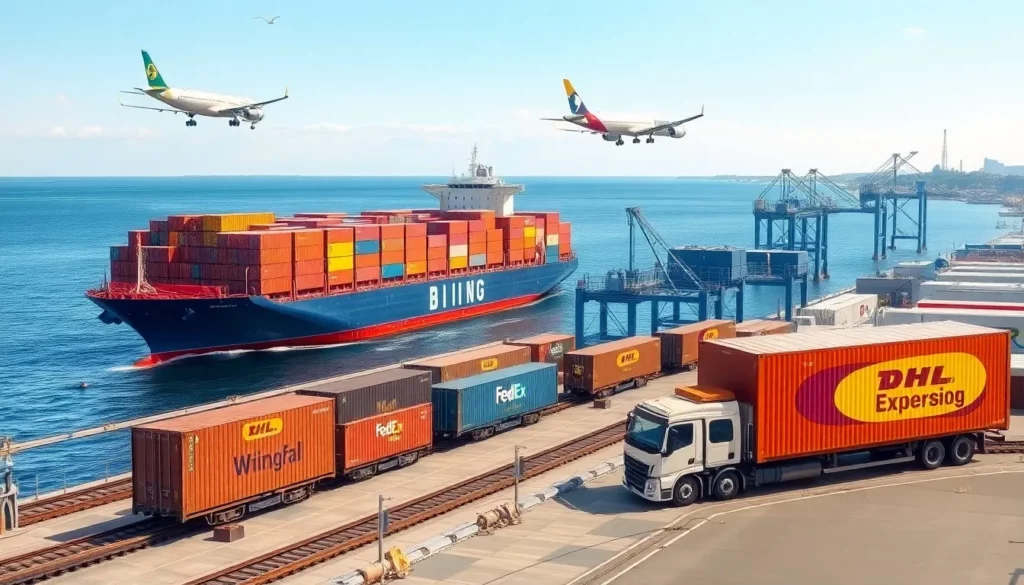Shipping goods from China to Sweden requires careful consideration of multiple transport methods, each offering distinct advantages in cost, speed, and reliability. This comprehensive ultimate guide analysis examines sea freight, air cargo, rail transport, and express courier services, providing detailed shipping method, cost comparisons and transit time evaluations to help you select the most effective shipping method for your specific business requirements.
Reliable freight forwarding services from China to Sweden encompass comprehensive logistics solutions including customs clearance, carrier relationships, and shipment tracking for global importers. The most cost-effective options typically involve sea freight with transit times of 30-45 days, while air freight provides expedited delivery in 3-7 days at higher costs.
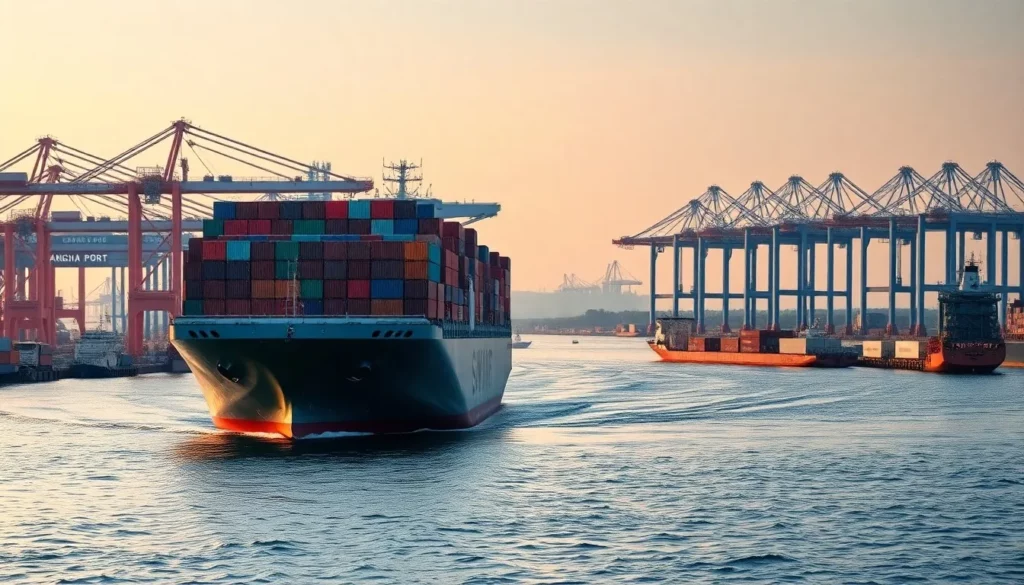
Core Freight Methods
Sea Freight: The Standard for Cost-Effective Bulk Shipping
Sea freight represents the most economical solution for transporting goods from China to Sweden, particularly suited for large-volume shipments and non-urgent deliveries. This method accommodates virtually any cargo type, from heavy machinery to consumer electronics, making it the backbone of China-Sweden trade relations.
The maritime route connecting China and Sweden benefits from well-established shipping lanes and frequent vessel schedules. Major Chinese ports maintain regular services to Swedish destinations, ensuring consistent capacity and competitive pricing throughout the year.
Full Container Load (FCL) Shipping: Large-Volume Importers
FCL shipping provides exclusive container use, offering maximum security and faster handling at both origin and destination ports. You pay a flat rate regardless of container utilization, making FCL particularly cost-effective when your cargo volume exceeds 15-20 cubic meters.
Container options include standard 20-foot units accommodating approximately 10 pallets and 40-foot containers holding up to 22 pallets. FCL shipments experience fewer handling touchpoints, reducing damage risk and expediting customs clearance processes.
Current FCL pricing from major Chinese ports to Swedish destinations ranges significantly based on seasonal demand and fuel costs. The standardized container format enables seamless intermodal connections, allowing rail transport from Swedish ports to inland destinations.
Less than Container Load (LCL) Shipping: SMEs and E-commerce Brands
LCL services enable cost-effective shipping for smaller cargo volumes by sharing container space with other importers’ goods. You pay only for the cubic meters your shipment occupies, making LCL ideal for businesses testing new markets or maintaining lean inventory levels.
LCL shipments require additional handling for consolidation in China and deconsolidation in Sweden, typically adding 3-5 days to transit times compared to FCL. However, this flexibility allows frequent shipments without minimum volume commitments.
The consolidation process involves careful cargo compatibility checks, ensuring your goods travel alongside appropriate products. Professional freight forwarders manage this coordination, optimizing container utilization while maintaining shipment integrity.
Key Ocean Trade Lanes:
Shanghai Port, as China’s busiest container facility, offers the most frequent sailings to Sweden with extensive carrier options and competitive rates. The port’s advanced infrastructure and efficient operations make it the preferred choice for many importers.
Shenzhen Port serves southern China’s manufacturing hub, particularly electronics and high-tech products destined for Sweden. Multiple terminals within the Shenzhen port complex provide flexibility in scheduling and routing options.
Ningbo Port’s deep-water capabilities and proximity to major manufacturing centers make it ideal for heavy cargo and bulk shipments. The port’s strategic location offers direct access to China’s industrial heartland.
Port of Gothenburg handles approximately 800,000 containers annually, making it Scandinavia’s largest container port and the primary gateway for Chinese imports. Its extensive rail and road connections facilitate efficient inland distribution throughout Sweden.
Stockholm Port primarily serves eastern Sweden and the Baltic region, while Malmö Port provides strategic access to both Swedish and Danish markets through its proximity to the Øresund Bridge connection.
Transit Times and Delays
| Departure Port | Arrival Port | Transit Time |
|---|---|---|
| Shanghai | Gothenburg | 30-40 days |
| Shenzhen | Gothenburg | 33-43 days |
| Ningbo | Gothenburg | 31-41 days |
| Shanghai | Stockholm | 32-42 days |
Transit times vary based on several critical factors including direct versus transshipment routes, with direct sailings reducing journey time by 5-10 days. Port congestion during peak seasons, particularly Chinese New Year and European summer holidays, can extend transit times significantly.
Weather conditions, especially winter storms in the North Sea and Baltic regions, occasionally impact schedules. Customs processing efficiency at both Chinese export and Swedish import facilities also influences overall delivery timelines.
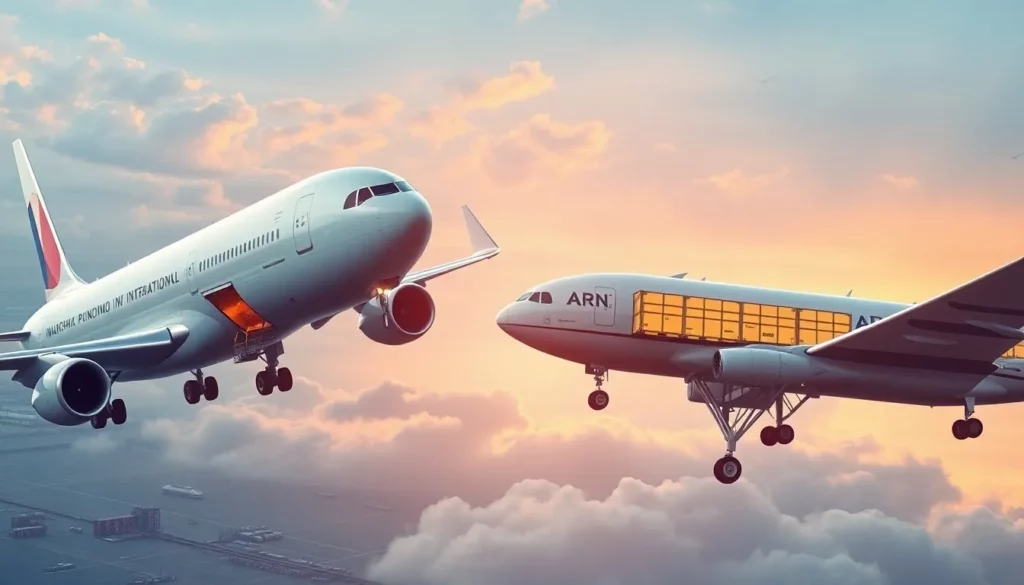
Air Freight: High-Value or Time-Sensitive Goods
Air freight provides the fastest shipping option from China to Sweden, typically delivering goods within 3-7 days from airport to airport. This method suits high-value products, urgent shipments, and items requiring temperature-controlled environments.
Chinese airports maintain frequent passenger and cargo flights to Sweden, with multiple daily options through major European hubs. The aviation infrastructure supports various aircraft types, accommodating different cargo sizes and weight requirements.
Standard Air Cargo vs. Express Air Freight
Standard air cargo utilizes scheduled passenger flights’ belly capacity or dedicated cargo aircraft, offering cost-effective solutions for larger air shipments. This service typically requires 5-7 days for complete delivery including ground handling and customs clearance.
Express air freight employs dedicated express carrier networks, providing door-to-door service with enhanced tracking and priority handling. Express services achieve 2-3 day delivery but command premium pricing reflecting their speed and convenience.
Standard air cargo allows greater weight and dimensional flexibility compared to express services, making it suitable for industrial components and larger commercial shipments requiring air transport speed.
Choose Air Freight: Cost-Benefit for Importers
Air freight becomes cost-justified when shipment value exceeds $50 per kilogram or when inventory carrying costs surpass the transport premium. Time-sensitive products facing stockouts or seasonal demand spikes often warrant air transport despite higher costs.
High-value electronics, pharmaceutical products, and fashion items frequently utilize air freight to minimize inventory investment and respond quickly to market demands. The reduced transit time also decreases insurance costs and working capital requirements.
Calculate total landed cost including inventory carrying charges, potential stockout costs, and customer service implications when comparing air versus sea freight options.
Main Air Cargo Hubs:
Shanghai Pudong International Airport (PVG) serves as China’s primary international cargo hub, offering multiple daily flights to Stockholm Arlanda with various carriers. The airport’s advanced cargo facilities and customs processing capabilities ensure efficient export procedures.
Beijing Capital International Airport (PEK) provides northern China access with direct and connecting flights to Swedish destinations. Guangzhou Baiyun International Airport (CAN) serves southern China’s manufacturing regions with competitive cargo rates.
Stockholm Arlanda Airport (ARN) handles the majority of Sweden’s international air cargo, featuring modern cargo terminals and efficient customs processing. Gothenburg Landvetter Airport (GOT) serves western Sweden with growing cargo capacity supporting the region’s industrial base.
Estimated Air Freight Transit Times
| Origin Airport | Destination Airport | Transit Time |
|---|---|---|
| Shanghai (PVG) | Stockholm (ARN) | 5-7 days |
| Beijing (PEK) | Stockholm (ARN) | 5-8 days |
| Guangzhou (CAN) | Gothenburg (GOT) | 6-9 days |
| Shenzhen (SZX) | Stockholm (ARN) | 6-8 days |
Transit times include export customs clearance in China, flight time, import customs processing in Sweden, and final delivery. Direct flights achieve shorter transit times, while connections through European hubs may add 1-2 days.
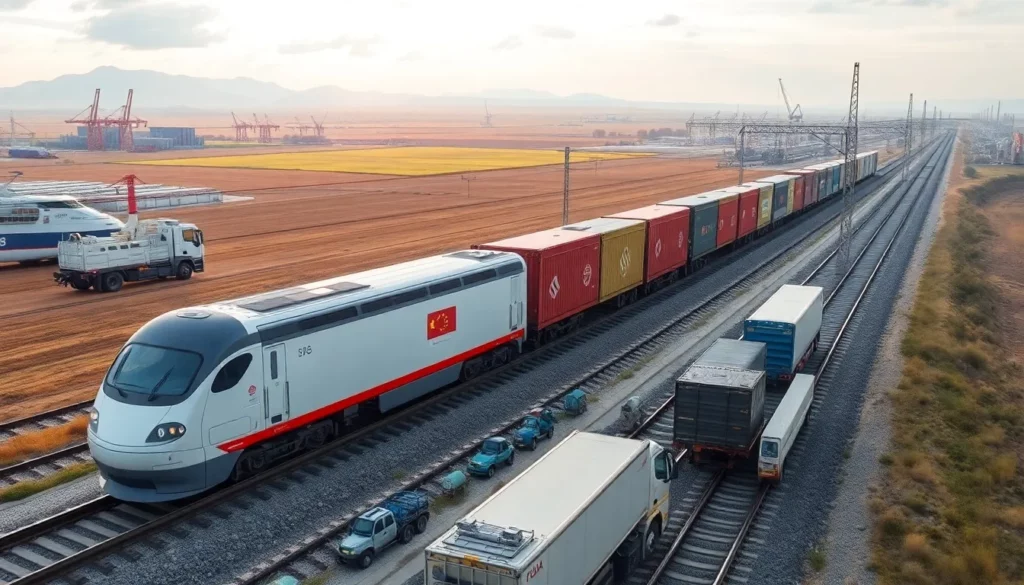
Rail Freight: Balanced for Cost and Speed
Rail freight via the China-Europe Railway Express offers an attractive middle ground between sea and air transport, typically requiring 18-25 days for station-to-station delivery. This option provides cost savings of up to 50% compared to air freight while delivering twice as fast as sea transport.
The rail network connects major Chinese manufacturing centers with European distribution hubs, offering reliable schedules and competitive pricing for medium-volume shipments.
China-Europe Railway to Sweden
The established rail route from China to Sweden typically follows the path through Alashankou Port in Xinjiang, crossing Kazakhstan, Russia, and Poland before reaching European distribution centers. A new dedicated route launched in 2024 connects Wuhan directly to Gothenburg, reducing transit time to approximately 23 days.
Rail shipments from China first consolidate in major inland hubs like Chengdu or Chongqing before joining the transcontinental railway network. Upon reaching Europe, goods undergo customs clearance in Hungary or Czech Republic before final delivery to Sweden.
This intermodal approach combines rail efficiency with local trucking for first-mile pickup in China and last-mile delivery in Sweden, providing comprehensive door-to-door service.
Rail Transport: Consumer Goods, Electronics
Rail freight excels for consumer electronics, automotive components, and manufactured goods requiring faster delivery than sea freight allows. The service particularly benefits products with moderate time sensitivity and stable demand patterns.
Temperature-controlled rail cars accommodate products requiring climate control, expanding the range of suitable cargo types. The reduced handling compared to sea freight minimizes damage risk for fragile or precision products.
Weight and dimensional restrictions apply, making rail freight most suitable for goods with favorable weight-to-value ratios that justify the transport premium over sea freight.
Rail vs. Sea vs. Air Freight: Cost, Time, and Reliability
Rail freight typically costs 2-3 times more than sea freight but provides significantly faster delivery, making it cost-effective for inventory-sensitive products. Compared to air freight, rail offers substantial savings while maintaining reasonable transit times for many product categories.
Reliability factors include consistent schedules, reduced weather dependency compared to sea transport, and fewer security concerns than trucking alternatives. However, political tensions or infrastructure disruptions along the route can occasionally impact service.
The environmental benefits of rail transport appeal to companies prioritizing sustainability goals while maintaining competitive logistics costs.
Estimated Rail Freight Transit Times and Intermodal
Station-to-station rail transit typically requires 14-16 days, with additional time for first-mile collection in China and last-mile delivery in Sweden. Door-to-door service usually completes within 28-35 days, depending on customs processing efficiency and inland transportation scheduling.
Seasonal variations affect rail performance, with winter conditions occasionally causing delays. However, the rail network generally maintains more consistent schedules than ocean shipping, which faces greater weather-related disruptions.
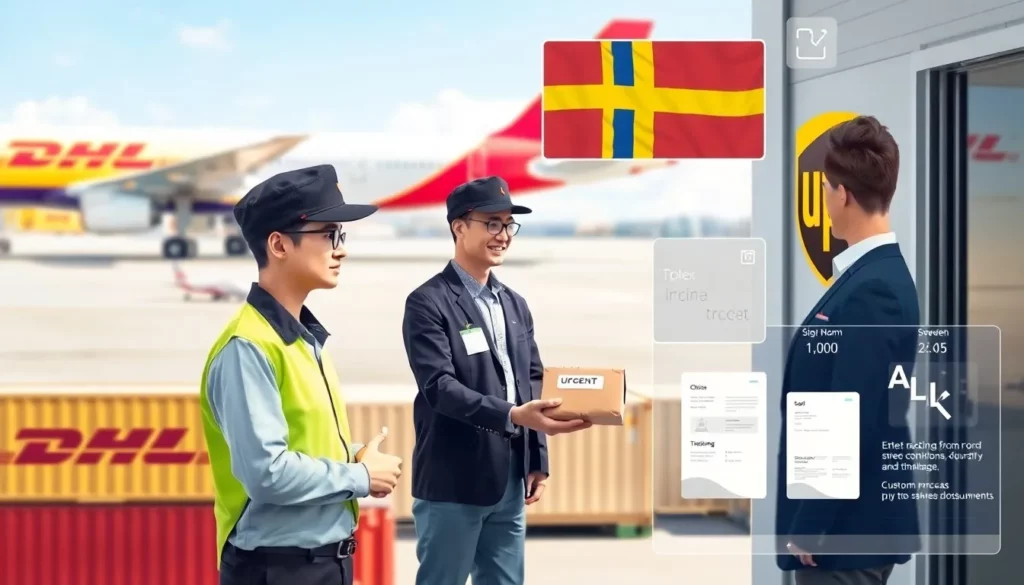
Express Courier: Fastest Door-to-Door
Express courier services provide the ultimate in speed and convenience, delivering packages from China to Sweden in 2-5 days with complete door-to-door service. These services excel for urgent documents, product samples, and high-value small packages requiring maximum security.
Global express carriers maintain extensive networks in both China and Sweden, offering pickup scheduling, real-time tracking, and guaranteed delivery times backed by service level agreements.
Major Express Couriers: DHL, FedEx, UPS
DHL maintains the strongest presence in both Chinese and Swedish markets, offering daily pickup services and comprehensive tracking capabilities. Their network provides multiple service levels from economy to next-day delivery options.
FedEx and UPS provide competitive alternatives with strong air networks and ground delivery capabilities in Sweden. Each carrier offers specialized services for different cargo types and delivery requirements.
Express carriers handle all customs documentation and clearance procedures, simplifying the shipping process for occasional shippers or urgent shipments requiring minimal administrative burden.
Ideal Use Cases: Small Parcels, Samples, and Urgent Documents
Product samples for evaluation or trade show display represent ideal express courier applications, where cost per kilogram becomes secondary to delivery reliability and speed. These shipments typically weigh under 50 kilograms and require careful handling.
Urgent replacement parts or components preventing production line shutdowns justify express courier premiums through avoided downtime costs. Time-critical documents or contracts also warrant express service for business continuity.
E-commerce returns or warranty replacements often utilize express services to maintain customer satisfaction levels despite higher transport costs.
Cost Structure and Dimensional Weight
Express carriers calculate charges based on the greater of actual weight or dimensional weight, with dimensional weight determined by length × width × height ÷ 6000 cubic centimeters per kilogram. This calculation method reflects aircraft cargo space limitations.
| Carrier | Weight Range | Rate Range (USD/kg) |
|---|---|---|
| DHL | ≥21kg | $6.70-8.00 |
| FedEx | ≥21kg | $6.80-8.50 |
| UPS | ≥21kg | $6.40-7.90 |
Additional surcharges apply for fuel costs, remote delivery areas, and special handling requirements. Peak season surcharges during Chinese New Year and Christmas periods can increase rates by 15-25%.
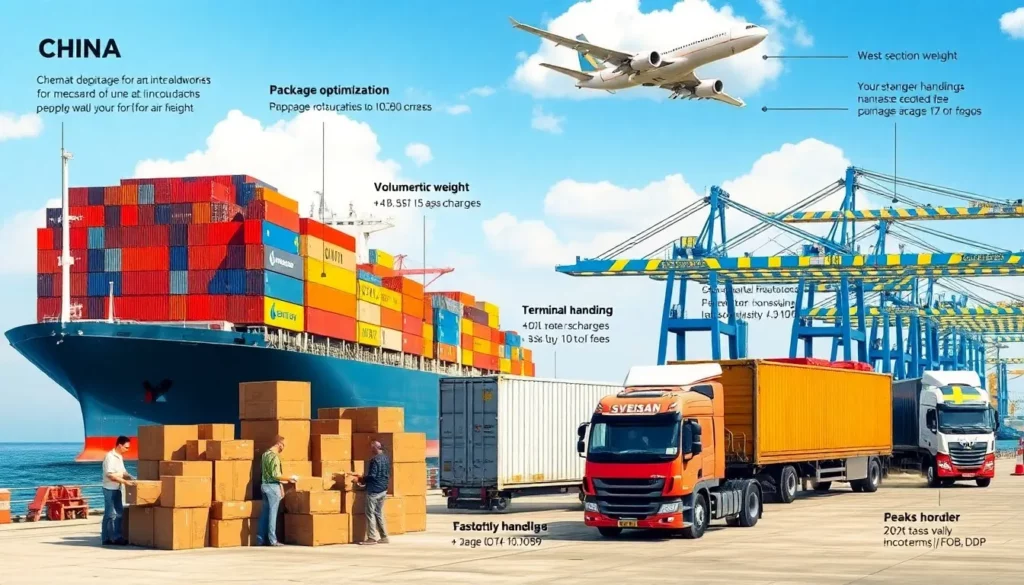
Shipping Costs from China to Sweden
Key Factors Influencing Final Freight:
Understanding cost components enables accurate budgeting and supplier negotiations, preventing unexpected charges that can significantly impact your landed costs. Multiple variables affect final pricing, requiring careful analysis of each element.
Freight rates fluctuate based on market conditions, fuel costs, capacity utilization, and seasonal demand patterns. Peak seasons typically increase rates by 20-40% above normal levels, particularly during Chinese manufacturing holidays and European import cycles.
Chargeable Weight:
Air freight calculations use the higher of actual weight or volumetric weight, with volumetric weight calculated as length × width × height ÷ 6000 for metric measurements. This reflects aircraft space constraints where volume often limits capacity before weight restrictions apply.
Sea freight LCL charges are based on cubic meters or weight, whichever produces higher revenue for the carrier. FCL shipments charge per container regardless of weight or volume utilization, making full container loads cost-effective for maximum utilization.
Understanding these calculations helps optimize packaging design to minimize chargeable weight, potentially reducing transport costs significantly for low-density products.
Dimensions and Volume
Package dimensions directly impact transport costs, especially for air freight where space premiums apply. Irregularly shaped packages may incur additional handling charges or require special equipment increasing overall costs.
Sea freight LCL typically costs $80-130 per cubic meter depending on origin and destination ports2. Optimizing packaging density can substantially reduce these charges while improving cargo protection during transit.
Consider packaging consolidation opportunities to maximize container utilization for FCL shipments or reduce cubic meter charges for LCL consignments.
Incoterms: EXW, FOB, DDP
Ex Works (EXW) terms place maximum responsibility on the buyer, who arranges all transport, insurance, and customs clearance from the supplier’s premises. This provides cost control but requires significant logistics expertise and local representation.
Free on Board (FOB) terms require the seller to deliver goods to the departure port and handle export customs clearance, while the buyer assumes responsibility from that point. FOB represents the most common arrangement for China-Sweden trade.
Delivered Duty Paid (DDP) places maximum responsibility on the seller, who handles all transport, customs, and delivery to the buyer’s premises. DDP simplifies purchasing but typically includes higher margins to cover the seller’s risk and complexity.
Fuel Surcharges, General Rate Increases (GRIs), and Peak Season Fees
Fuel surcharges fluctuate with oil prices, typically ranging from 10-25% of base freight rates. These surcharges adjust monthly or quarterly based on published fuel indices, affecting both air and sea freight costs.
General Rate Increases (GRIs) occur annually or semi-annually when carriers announce across-the-board rate adjustments. These increases typically range from 5-15% and reflect operational cost inflation and capacity constraints.
Peak season surcharges apply during high-demand periods, particularly September through November when Christmas inventory builds. These premiums can reach 100% above normal rates for air freight and 30-50% for sea freight.
Destination Charges: Terminal Handling, Customs Fees, and Last-Mile Delivery
Swedish port charges typically range from $60-150 per container for terminal handling and documentation. These fees cover cargo unloading, storage, and preparation for customs clearance or onward transport.
Customs clearance fees in Sweden typically cost $80-200 depending on shipment complexity and documentation requirements. Professional customs brokers provide expertise ensuring compliance while minimizing delays and penalties.
Last-mile delivery costs vary significantly based on destination accessibility, with urban deliveries typically costing less than remote locations. Appointment scheduling and special equipment requirements can increase final delivery charges.
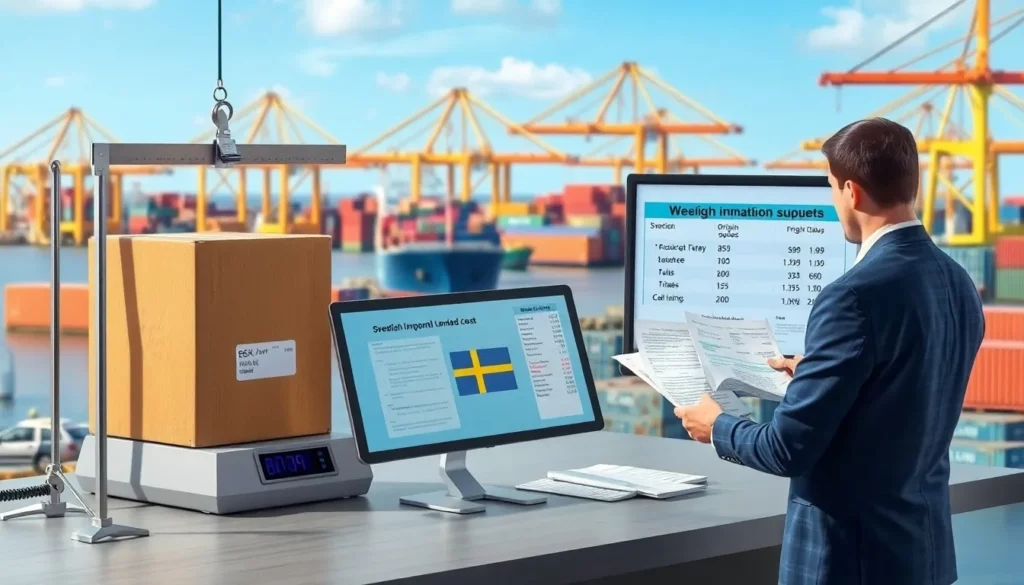
Accurately Calculate Total Landed Cost
Step 1: Gathering Necessary Shipment Information (Weight, Volume, HS Code)
Accurate weight and dimensional measurements enable precise freight calculations and prevent unexpected charges. Use certified scales and standard measuring tools to ensure consistency with carrier requirements.
Harmonized System (HS) codes determine applicable duty rates and import restrictions, making accurate classification essential for cost calculations. Incorrect classification can result in penalties, delays, and unexpected duty assessments.
Document product specifications, materials, and intended use to support proper HS code classification. Professional customs brokers can provide classification assistance for complex or uncertain products.
Step 2: Obtaining and Comparing Detailed, All-Inclusive Quotes
Request quotes from multiple freight forwarders including all charges from origin pickup to final delivery. Ensure quotes specify included services and identify any potential additional charges or surcharges.
Compare quotes on equivalent service levels, considering transit times, tracking capabilities, and insurance coverage. The lowest initial quote may not represent the best value when service quality and reliability factors are considered.
Verify carrier financial stability and service reputation through industry references and performance metrics before making final selections.
Step 3: Factoring in Swedish Import Duties and VAT (Mervärdesskatt)
Swedish import duties range from 0-20% based on product classification and country of origin. The European Union’s Taric system provides detailed duty rate information for specific product codes and supplier countries.
Swedish VAT (Mervärdesskatt) applies at 25% for most goods, 12% for foodstuffs, and 6% for books and magazines. VAT calculations are based on the customs value including product cost, transport, insurance, and applicable duties.
Businesses registered for Swedish VAT can typically reclaim import VAT through their regular VAT returns, while unregistered entities must pay VAT to Swedish Customs at import.
Hidden Costs to Watch For: A Checklist for Importers
Origin charges may include export customs clearance, terminal handling, and documentation fees not clearly itemized in initial quotes. Verify which services are included and which require additional payment.
Currency fluctuation can impact final costs when payments are due in different currencies than quoted. Consider forward exchange contracts for large shipments to lock in favorable rates.
Demurrage and storage charges accrue when containers or cargo remain at terminals beyond free time allowances. Plan customs clearance and pickup scheduling to avoid these penalty charges.

Strategies for Reducing Shipping Expenses
For E-commerce Sellers: Optimizing Packaging and Consolidating Shipments
Packaging optimization reduces dimensional weight charges for air freight and maximizes container utilization for sea freight. Use appropriate packaging materials providing adequate protection while minimizing weight and volume.
Shipment consolidation combines multiple small orders into larger, more cost-effective shipments. This strategy requires demand forecasting and inventory planning to balance shipping savings against inventory carrying costs.
Consider utilizing Swedish fulfillment centers for faster domestic delivery while maintaining inventory cost control through periodic container shipments from China.
For Large Retailers: Negotiating Long-Term Contracts and Volume Discounts
Annual contracts with freight forwarders and carriers typically provide 10-20% savings compared to spot rates. These agreements also guarantee capacity during peak seasons when space becomes scarce.
Volume commitments enable negotiated rates reflecting shipping patterns and seasonal requirements. Larger importers can negotiate customized service levels and value-added services within contracted rates.
Strategic carrier relationships provide priority handling during peak periods and enhanced communication channels for problem resolution.
For SMEs: Leveraging LCL and Groupage Shipping Options
LCL shipping enables regular inventory replenishment without minimum volume requirements, supporting just-in-time inventory strategies. Professional freight forwarders can coordinate consolidation with compatible cargo to optimize costs.
Groupage services combine multiple SME shipments under master freight arrangements, providing economies of scale typically available only to larger shippers. These services require flexible timing to accommodate consolidation schedules.
Digital freight platforms increasingly offer LCL space matching services, providing transparency and competitive pricing for smaller shippers.

Swedish Customs Clearance for Imports from China
Essential Documentation for a Smooth Customs Process
Commercial Invoice and Packing List Requirements
Commercial invoices must accurately reflect the transaction value, including detailed product descriptions, quantities, and individual unit values. Swedish Customs uses this information to assess duties and VAT obligations, making accuracy essential for smooth clearance.
The invoice should specify currency, payment terms, and delivery conditions according to the agreed Incoterms. Include supplier and buyer contact information with complete addresses and tax identification numbers where applicable.
Packing lists provide detailed cargo information including individual package contents, weights, and dimensions. This documentation helps customs officers verify shipment contents and identify any discrepancies requiring further inspection.
Bill of Lading (B/L) for Sea Freight or Air Waybill (AWB) for Air Freight
Bills of Lading serve as contracts of carriage, receipts for goods, and documents of title for sea freight shipments. Original bills of lading are typically required for cargo release, making proper handling and courier delivery crucial for timely clearance.
Air Waybills function similarly for air freight but are not documents of title, simplifying the clearance process. Electronic air waybills increasingly replace paper documents, expediting processing and reducing handling errors.
These transport documents must accurately reflect consignee information matching import licenses and customs registrations to prevent clearance delays.
Certificate of Origin and Other Required Permits for Specific Goods
Certificates of origin may qualify goods for preferential duty treatment under various trade agreements. China’s membership in RCEP and other agreements can provide significant duty savings for qualifying products.
Specific product categories require additional permits or certifications, including medical devices, food products, cosmetics, and electronic equipment. Research applicable requirements early in the sourcing process to avoid delays and compliance issues.
Professional customs brokers maintain current knowledge of changing regulations and can advise on documentation requirements for specific product categories.
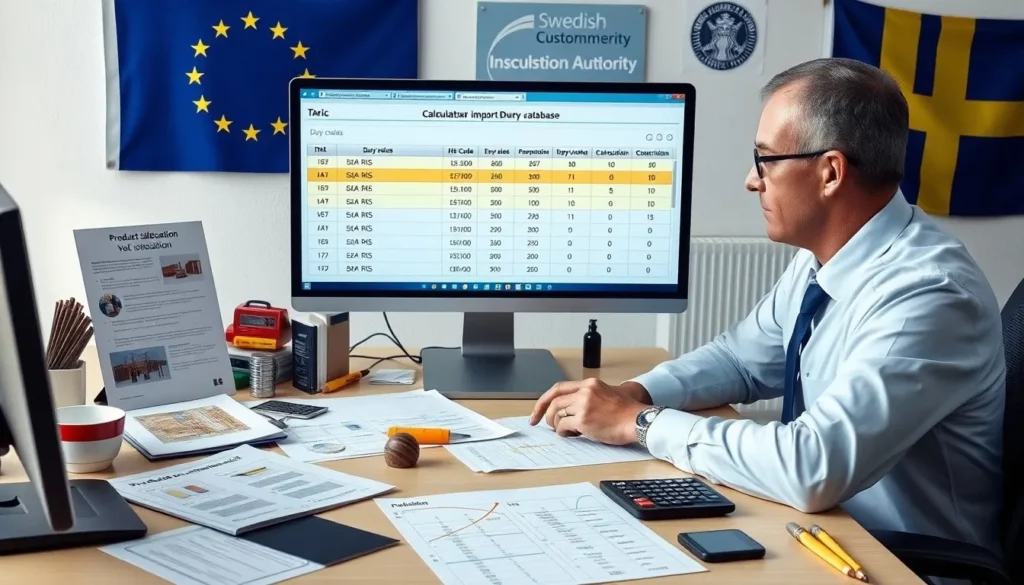
Understanding and Calculating Import Duties and Taxes in Sweden
The Role of the HS Code (Harmonized System) in Determining Duty Rates
Harmonized System codes provide the foundation for duty rate determination, with each six-digit code corresponding to specific products and associated duty rates. Sweden follows European Union duty schedules, with rates varying from 0% for certain raw materials to 20% for manufactured goods.
Proper classification requires detailed product knowledge including materials, construction methods, and intended use. Misclassification can result in incorrect duty assessments, penalties, and shipment delays requiring professional rectification.
Consider obtaining binding tariff information (BTI) rulings from Swedish Customs for complex or high-value products to ensure consistent classification and duty treatment.
Calculate Swedish VAT (Mervärdesskatt) on Imported Goods
Swedish VAT applies to the customs value, which includes the product cost, transport charges, insurance, and applicable duties. The standard VAT rate of 25% applies to most imported goods, with reduced rates for specific categories.
VAT calculation: (Product Value + Transport + Insurance + Duties) × VAT Rate = VAT Due
Businesses registered for Swedish VAT typically reclaim import VAT through their periodic VAT returns, while unregistered entities must pay VAT to customs at the time of import.
Swedish Customs Authority (Tullverket) Website for Tariff Information
The Swedish Customs Authority website provides access to the European Union’s Taric database, containing detailed duty rates, restrictions, and documentation requirements for all product classifications.
The Taric query system allows searching by product description or HS code to identify applicable duty rates and any special conditions or restrictions. This resource provides the most current information reflecting recent trade agreement changes and regulatory updates.
Regular consultation of official customs resources ensures compliance with current regulations and helps identify opportunities for duty optimization through proper classification or trade agreement utilization.

The Role of a Freight Forwarder in Customs Brokerage
How a Forwarder Manages Customs Declarations and Compliance
Professional freight forwarders maintain customs brokerage licenses and employ qualified personnel familiar with Swedish import regulations. They prepare and submit electronic customs declarations on behalf of importers, ensuring accuracy and compliance.
Forwarders monitor regulatory changes affecting their clients’ products and provide advance notification of new requirements or opportunities. This proactive approach prevents compliance issues and identifies cost-saving opportunities.
Established forwarders maintain relationships with customs officials and can expedite problem resolution when issues arise during the clearance process.
Delivered Duty Paid (DDP) Shipping for Simplified Customs Handling
DDP terms place complete responsibility for customs clearance on the supplier or their designated agent, simplifying the process for buyers unfamiliar with Swedish import procedures. The seller handles all documentation, payments, and delivery arrangements.
DDP pricing typically includes margins to cover the seller’s risk and administrative burden, potentially increasing costs compared to buyer-controlled arrangements. However, this convenience eliminates customs-related delays and compliance concerns for the buyer.
Consider DDP arrangements for initial shipments or small-volume imports where customs expertise development doesn’t justify the investment.
Economic Operator Registration and Identification (EORI) Number
EORI numbers are required for all customs transactions within the European Union, including Sweden. This unique identifier links all customs activities to the registered entity, enabling tracking and compliance monitoring.
Apply for EORI registration through Swedish Customs before your first import to avoid delays. The registration process typically requires several days and includes verification of business registration and contact information.
Maintain current EORI registration information including address changes and authorized representatives to ensure uninterrupted customs processing capabilities.

Select the Optimal Shipping Strategy for Your Business
Evaluation Criteria for Choosing a Shipping Method
Balancing Transit Time vs. Shipping Cost Based on Your Inventory Needs
Inventory carrying costs, stockout penalties, and customer service requirements drive the transit time versus cost equation. Products with high inventory carrying costs or seasonal demand patterns often justify premium transport to minimize total supply chain costs.
Calculate total landed cost including transport, inventory carrying charges, insurance, and opportunity costs to determine the optimal shipping method. This analysis often reveals that faster transport reduces total costs despite higher transport rates.
Consider demand forecasting accuracy when evaluating transport options, as uncertain demand patterns favor faster transport methods to maintain service levels while minimizing inventory investment.
Assessing Cargo Type, Size, and Weight Constraints
Product characteristics determine suitable transport modes, with heavy, low-value products typically favoring sea freight while lightweight, high-value items often justify air transport. Dimensional constraints may eliminate certain options regardless of cost considerations.
Fragile or temperature-sensitive products require specialized handling available through premium services, potentially eliminating lower-cost options that lack appropriate capabilities.
Hazardous materials face transport restrictions that may limit modal choices or require specialized carriers with appropriate certifications and equipment.
Evaluating Risk and Insurance Needs for Different Freight Options
Transport risk varies significantly among shipping methods, with sea freight exposing cargo to weather, handling, and security risks over extended periods. Air freight provides reduced exposure time but faces different risk profiles including handling damage and weather delays.
Insurance costs reflect these risk differences, with sea freight typically requiring higher premiums due to extended exposure periods and varied handling conditions. However, the absolute insurance cost may be lower due to reduced cargo values for price-sensitive products using sea transport.
Consider self-insurance capabilities and risk tolerance when evaluating transport options, as premium services may provide risk mitigation worth their additional cost.
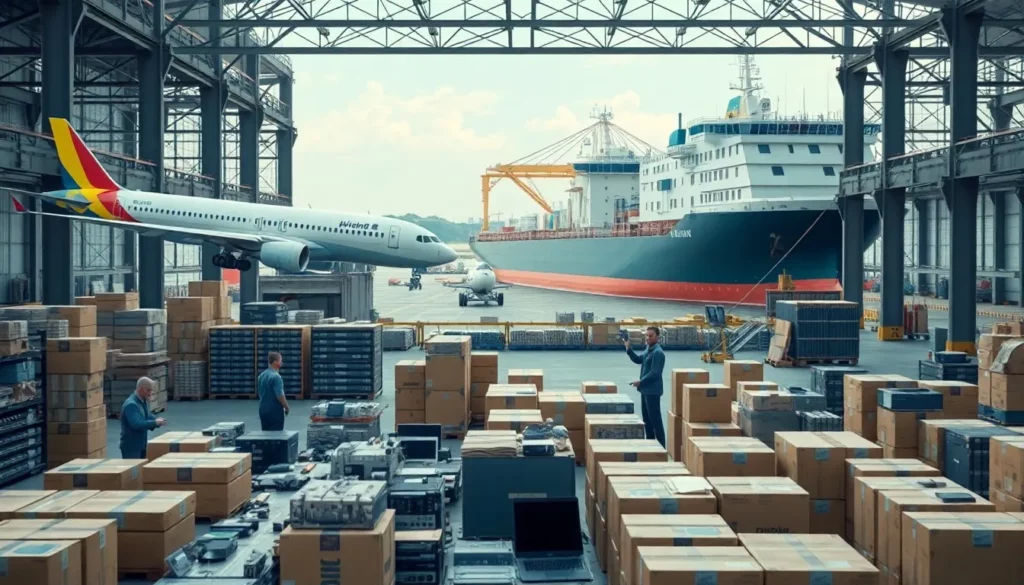
Tailoring Shipping Strategies
Case Study: Optimizing a Shipment of Electronics for an E-commerce Brand
A Swedish e-commerce company importing consumer electronics from Shenzhen faces inventory velocity pressures requiring frequent replenishment. Their 500kg weekly shipments favor air freight despite higher costs, as the inventory carrying cost savings and customer service benefits justify the premium.
The company utilizes 2-day express service for fast-moving items while employing 5-day standard air service for regular replenishment. This dual approach balances service levels with transport costs, optimizing total supply chain performance.
Seasonal demand fluctuations drive strategic inventory building through occasional sea freight shipments, reducing air freight dependency during peak periods while maintaining service levels through advance planning.
Case Study: Bulk FCL Shipment for a Major Swedish Retailer
A major Swedish retailer importing furniture from Guangzhou optimizes transport costs through 40-foot container shipments scheduled around seasonal demand patterns. Their quarterly shipments align with promotional calendars, maximizing inventory turnover while minimizing transport costs.
The retailer negotiates annual contracts with ocean carriers providing guaranteed space and preferred rates during peak seasons. This strategic approach ensures capacity availability while achieving significant cost savings compared to spot market rates.
Container optimization includes mixed product loading to maximize weight and volume utilization, reducing per-unit transport costs while maintaining assortment variety for retail operations.
Case Study: Cost-Benefit Analysis of Rail vs. Sea for a Mid-Sized Distributor
A mid-sized distributor importing automotive parts from Wuhan evaluates rail versus sea freight for their monthly 15-cubic-meter shipments. Rail transport’s 25-day transit time provides inventory benefits compared to 40-day sea freight, potentially justifying the 40% cost premium.
Analysis reveals that reduced inventory carrying costs and improved customer service capabilities offset the higher transport costs, making rail freight the optimal choice. The distributor’s ability to maintain lower safety stock levels provides additional working capital benefits.
The new Wuhan-Gothenburg rail service offers direct routing advantages, eliminating transshipment delays and providing schedule reliability supporting just-in-time inventory strategies.
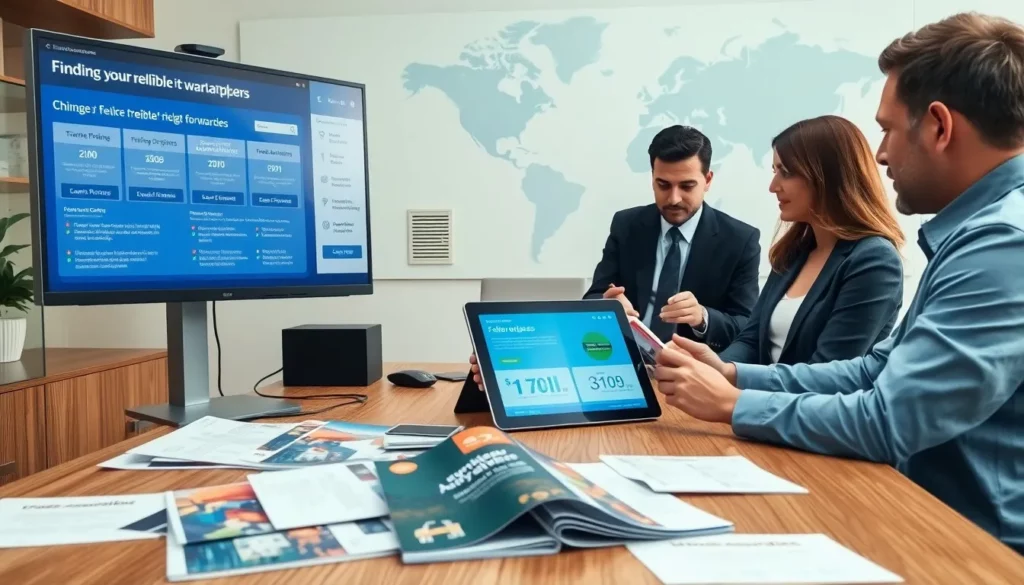
Find and Vet Reliable Freight Forwarders
Sourcing Channels for Identifying Potential Forwarding Partners
Online Freight Marketplaces and Logistics Directories
Digital freight platforms provide transparent pricing and service comparisons across multiple forwarders, enabling informed decision-making based on specific requirements. These platforms often include user reviews and performance ratings supporting vendor evaluation.
Alibaba’s logistics platform leverages extensive supplier relationships and integrated services, potentially providing simplified coordination for businesses already using Alibaba sourcing services. The platform’s trade assurance features add security for international transactions.
Online marketplaces facilitate quote comparison and service level analysis, but require careful verification of provider credentials and capabilities beyond basic pricing information.
Referrals from Industry Associations and Business Networks
Industry associations often maintain preferred provider directories based on member experiences and performance standards. These referrals carry additional credibility through association verification processes and ongoing member feedback.
Chamber of commerce organizations in both China and Sweden can provide networking opportunities and referral sources based on local market knowledge and business relationships.
Professional networking platforms and industry forums provide informal feedback channels for evaluating forwarder performance and identifying potential partners through peer recommendations.
Search Engine Queries
Search engine optimization efforts by logistics providers often reflect their market focus and investment in specific trade lanes. Providers emphasizing China-Sweden expertise demonstrate commitment to this route and likely possess relevant experience.
Website content quality and technical sophistication often indicate operational capabilities and customer service standards. Professional presentation suggests appropriate investment in business infrastructure and customer communication systems.
Social media presence and content sharing demonstrate market engagement and thought leadership, indicating providers staying current with industry developments and regulatory changes.
Supplier Recommendations and Local Trade Chambers
Existing suppliers often maintain relationships with reliable logistics providers and can provide performance-based recommendations. These referrals benefit from ongoing business relationships and demonstrated service quality.
Local trade chambers in major Chinese manufacturing centers maintain logistics provider databases and can facilitate introductions based on specific route requirements and service needs.
Cross-referencing multiple recommendation sources helps identify consistently high-performing providers while avoiding potential bias from single-source referrals.

Key Criteria for Vetting Freight Forwarders
Verifying Experience
Swedish customs expertise requires current knowledge of regulations, documentation requirements, and clearance procedures specific to various product categories. Request examples of recent clearances and regulatory compliance initiatives.
Verify customs brokerage licenses and professional certifications relevant to Swedish import operations. Licensed customs brokers maintain current regulatory knowledge and carry professional liability insurance protecting clients.
Assess the forwarder’s relationship with Swedish customs officials and their ability to resolve issues efficiently when complications arise during the clearance process.
Network Strength and Physical Presence
Physical presence in both countries enables direct oversight of cargo handling and provides local expertise for problem resolution. Verify office locations, warehouse facilities, and operational capabilities in key locations.
Network partnerships with reputable agents provide extended capabilities while maintaining service quality standards. Evaluate partner credentials and performance standards maintained by the primary forwarder.
Technology integration across the network enables seamless information flow and coordinated service delivery from origin to destination.
Protocols, Tracking Technology, and Customer Service Responsiveness
Communication standards should include proactive status updates, problem notification procedures, and designated account management contacts. Test response times and communication quality during the evaluation process.
Tracking technology should provide real-time visibility into shipment status, documentation processing, and delivery scheduling. Web-based platforms enable independent monitoring and reduce communication overhead.
Customer service capabilities include after-hours support, multilingual communication abilities, and escalation procedures for urgent issues requiring immediate attention.
Analyzing Case Studies or Client Testimonials
Industry-specific experience demonstrates understanding of unique requirements, regulatory considerations, and service expectations relevant to your business needs. Request case studies highlighting similar shipments or challenges.
Client testimonials provide insights into service quality, problem resolution capabilities, and overall satisfaction levels. Seek references from companies with similar shipping patterns and service requirements.
Long-term client relationships indicate consistent service quality and adaptability to changing business needs over time. High client retention rates suggest superior service delivery and competitive value propositions.

Red Flags to Avoid When Selecting a Logistics Partner
Surcharges or Destination Fees
Unrealistic pricing often indicates incomplete quotes missing essential services or unexpected charges appearing later in the process. Request detailed breakdowns identifying all potential costs and service inclusions.
Compare quotes on equivalent service levels including the same coverage of pickup, delivery, customs clearance, and documentation services. Ensure all quotes specify the same delivery terms and responsibilities.
Professional forwarders provide transparent pricing with clear explanations of potential additional charges based on actual circumstances requiring extra services or handling.
Lack of Proper Licensing, Insurance, and International Certifications
Operating licenses verify legal authority to provide freight forwarding services and customs brokerage in relevant jurisdictions. Request license verification and confirm current status with issuing authorities.
Professional liability insurance protects clients against errors and omissions in service delivery. Verify coverage amounts and policy terms applicable to your shipment values and requirements.
International certifications such as IATA membership for air cargo or NVOCC licensing for ocean freight demonstrate industry recognition and adherence to professional standards.
Vague or Non-Committal Answers Regarding Transit Times and Processes
Professional forwarders provide specific transit time estimates based on historical performance and current conditions. Vague responses suggest inexperience or reluctance to commit to performance standards.
Detailed process explanations demonstrate operational knowledge and ability to manage potential complications effectively. Request step-by-step descriptions of handling procedures and contingency plans.
Performance guarantees or service level commitments indicate confidence in operational capabilities and willingness to stand behind service promises with measurable standards.
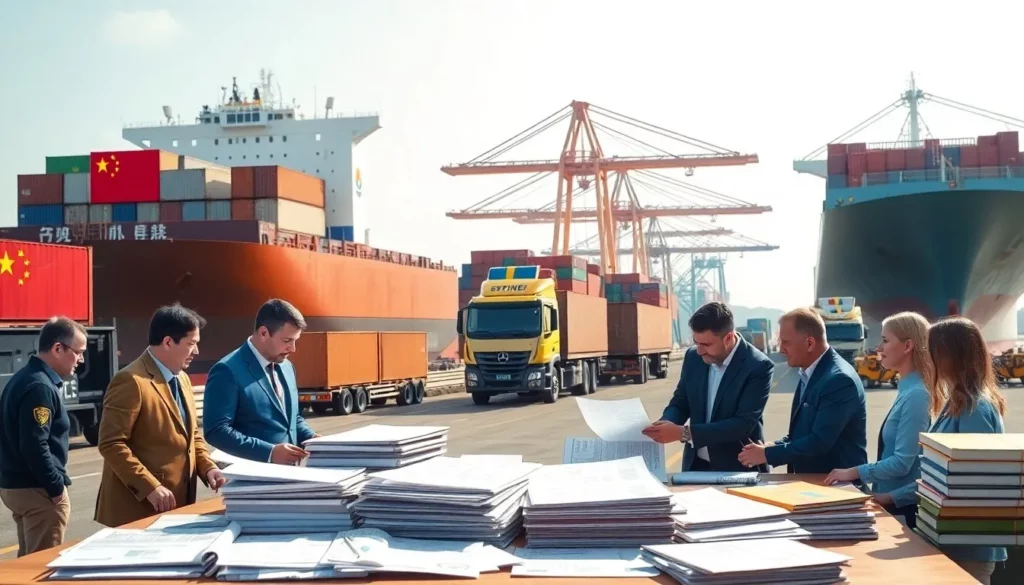
Conclusion:
Successful imports require careful planning, proper documentation, and reliable logistics partnerships to navigate the complexity of international trade regulations and transport options. Verify product classification accuracy, complete customs documentation requirements, and establish clear communication protocols with your chosen freight forwarder.
Consider total landed cost calculations including transport, duties, taxes, and handling charges when evaluating suppliers and transport options. This comprehensive approach ensures accurate pricing and avoids unexpected costs impacting profitability.
Professional freight forwarders bring expertise, established relationships, and operational capabilities that can significantly improve your import efficiency while reducing costs and risks. Their knowledge of current regulations, transport options, and best practices provides value beyond simple transport arrangements, supporting your business growth and operational success in the China-Sweden trade corridor.
Frequently Asked Questions (FAQs)
1. What are the most common reasons for customs delays when shipping from China to Sweden, and how can I prevent them?
Common delays include incomplete documentation, incorrect product classification, missing permits for regulated goods, and invoice discrepancies. Prevent delays by working with experienced customs brokers, maintaining accurate documentation, and obtaining proper classifications before shipment.
2. How do Incoterms like FOB and DDP impact my responsibilities and total costs as an importer?
FOB terms require you to arrange transport from Chinese ports and handle import customs clearance, providing cost control but requiring logistics expertise. DDP terms place all responsibilities on the supplier, simplifying your process but typically including higher costs to cover the supplier’s risk and complexity.
3. What is the most cost-effective way to ship small parcels or samples to Sweden for product evaluation before placing a bulk order?
Express courier services provide the fastest option for samples under 50kg, while standard air freight offers better rates for larger sample shipments. Consider the time value of evaluation processes when selecting between 2-day express and 5-7 day standard air service.
4. How far in advance should I book my shipment, especially during peak seasons like the holidays or Chinese New Year?
Book ocean freight 3-4 weeks in advance during normal periods and 6-8 weeks during peak seasons. Air freight requires 1-2 weeks advance booking normally and 3-4 weeks during peak periods when capacity becomes constrained and rates increase significantly.
5. What level of cargo insurance is necessary, and does the freight forwarder’s standard liability provide enough coverage for my goods?
Freight forwarder liability typically covers only $500-1000 per package, requiring additional cargo insurance for valuable shipments. Purchase all-risk cargo insurance covering 110% of invoice value plus freight costs to ensure adequate protection against loss or damage during transport.

